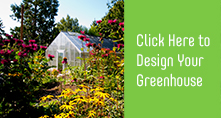Newsletters & Company News
Greenhouse Newsletter - Combination Shed & Greenhouse
January 1st, 2006:
| GREENHOUSE GAB January 2006 Volume 9 IN THIS ISSUE |
|
|
Don't Throw Out Your Poinsettia
Your poinsettia can last many years if taken care of properly.and you can even get it to rebloom in the future. They can continue to make a wonderful houseplant indoors, or can be enjoyed outside when temperatures are warmer.
In February or early March, cut back each of the old flowering stems to 4 - 6 inches in height to promote new growth. In June or July repot your poinsettia into a pot that is 2 - 3 inches larger in diameter. The poinsettia may be kept outdoors providing night temperatures are not lower than 60 degrees F. The plant will need to be placed in complete shade for the first two or three weeks, allowing it to become acclimated to its new environment. Sink the pot into a sunny morning location. Light shade in the afternoon is preferred. If you are sinking the pot into the ground, turn the pot a quarter turn each week to prevent rooting through the bottom of the pot and to promote even growth.
If you prefer a short plant with several flowers, pinch out the new growth to encourage branching. This should be done at 3 - 4 week intervals. Always leave 2 or 3 large fully expanded leaves below the pinch. Continue this practice until mid August and keep the plant growing actively all summer by regular watering and feeding every 2 weeks with a 20-20-20 fertilizer.
Bring your poinsettia into the house in the fall before night temperatures fall below 60 degrees F and keep it in a sunny place. It is always a good idea to rinse your plants well and check for pests before bringing them indoors. Flowers will only begin to form when the days are a certain length, or, more accurately, when the nights are long enough. Without long nights, your poinsettia will continue to grow and produce leaves, but it will never flower. Even short periods of night lighting can interfere with the formation of flowers. If there is any light after 5:00 p.m. the plant must be covered with a heavy bag or dark cloth, or place in a dark closet.
Flowers begin in late September and early October. Dark periods longer than 12 hours are necessary, and most flowers will mature in 60 - 85 days. Keep your poinsettia completely dark from 5:00 p.m. to 8:00 a.m. from the end of September until December 15th. Night temperatures should be no less than 55 degrees F and not more than 70 degrees F during the day. During the day, give the poinsettia as much sunlight as possible. You should also reduce the amount of fertilizer given to the plant after it is brought indoors.
So, for those of you up to the challenge, keep your poinsettia and see if you can get it to rebloom next year. At the very least, saving your poinsettia will give you a lovely plant to use indoors or out. And, just to set the record straight, poinsettias are not poisonous!
Planning a Combination Shed and Greenhouse
Our customer, Brian, from Kingsville, Ontario shares with us the beautilful combination shed and greenhouse that he planned and built himself. Brian carefully outlined the plans for the shed taking into consideration the required height, width and length of the greenhouse kit he purchased from us. Brian built his shed and attached our lean-to. Brian, who enjoys growing plants and trees found in Carolinian Forests, has managed to come up with an excellent solution for those who want to combine storage with a working greenhouse. Thank you Brian for sending your photos to us.
There are many considerations to make before choosing your outdoor color scheme. Do you have a favorite color, or favorite color combinations? Monochromatic gardens are not only soothing, but also create a dramatic display. Opposite colors, or including many colors, greatly enhance the main color scheme, creating a much more satisfying picture. White is often used to break up color, and is the preferred choice for those who enjoy their gardens by moonlight. Purples, blues and reds are stunning against silver foliage, while yellows and whites stand out against dark greens. Consult a color wheel and look at different color combinations. You'll soon discover that you are drawn to certain colors and/or combinations.
Are you looking for a cool garden, or do you prefer the hot hues found in a tropical paradise? Blues and greens are considered cool colors, making flowers look further away than what they are. Reds and oranges are hot colors, making them appear closer than what they are.
Yellows - Bright yellow flowers and foliage with gold accents create the best impact when planted in a large block of "sunshine" with dark green foliage. Best color combination: Purple, Blue Oranges - Vivid orange flowers are the eye-catchers of the border and will add excitement to any garden. Best color combination: Purple, Blue Reds - There are several shades of reds range from a purple to orange tint. One word of caution, red an overpower a garden if used too freely. Best color combination: Yellow, Blue, Purple Pinks - Delicate shades of pinks create a peaceful feeling, while hot vibrant shades provide splashes of warm color. Best color combination: Purple, Blue, Green Purples - Rich purples add strength to the garden, while paler shades offer a delicate old fashioned charm. Purples make the best color base because of the diversity of color combinations. Best color combinations: Blue, Green, Yellow, Orange, Red, Pink Blues - Blues offer a cool, calming effect and a true blue flower is hard to come by. One of my favorites is the Blue Hydrangea. Best color combination: Purple, Yellow, Red Greens - Light soft greens, shades of dark greens or silver green foliage will enhance any garden and evoke a peaceful calm. Best color combination: Lovely with everything! Whites - Many plants are not pure white and have tinges of other colors. Whites add to gardens by breaking up color, or look splendid on their own. A definite must for moonlit gardens. Best color combination: Lovely with everything! Choosing your color scheme is the first step in planning a successful garden. Once you have decided on your colors, you can begin choosing plants. One word of caution.be extremely careful if mixing reds and pinks. There are some gardens that can pull this off, but this color combination is best avoided.
Backyard Greenhouses
A div. of Ecolad Corporation
1-800-665-2124
|
Written By: Shelley Awad![]() Visit the News page here..
Visit the News page here..







